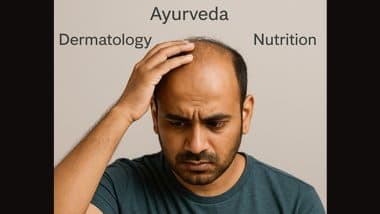Hair fall is not just a cosmetic issue. For many, it feels like an ongoing struggle that affects confidence and emotional well-being. With so many solutions available today, from oils and shampoos to supplements and transplants, it becomes difficult to separate fact from fiction. Among these, Traya has emerged as a brand that uses a multi-science approach. But the question remains: is Traya effective? Let’s unpack the method behind Traya’s treatment and understand how combining different sciences aims to tackle hair fall more comprehensively.
The Foundation of Traya’s Methodology
Traya’s philosophy rests on a simple belief: hair fall has multiple causes, and it needs multiple solutions.
- Hair loss is often the result of both internal and external factors.
- Hormonal imbalances, poor scalp health, nutritional deficiencies, and stress all play significant roles.
- Single solutions may help temporarily, but they rarely solve the problem long-term.
This is where Traya’s multi-science method comes in. By combining dermatology, Ayurveda, and nutrition, Traya attempts to cover all aspects of hair health in a personalised manner.
1. Dermatology: Targeting Scalp and Follicle Health
Dermatology focuses on what’s happening at the surface and root of the hair.
- Hair loss, especially male and female pattern baldness, is often linked to DHT (dihydrotestosterone).
- DHT attaches to hair follicles and causes them to shrink, leading to thinner hair and eventual hair loss.
- Dermatological solutions aim to slow this process by improving blood circulation and reducing inflammation in the scalp.
- Traya’s plans typically include prescription topicals that work on the scalp environment and promote healthier follicles.
Additionally, dermatologists assess scalp conditions such as dandruff or seborrheic dermatitis, which can worsen hair fall if left untreated.
2. Ayurveda: Balancing the Body’s Internal Environment
Ayurveda looks at hair fall from a systemic perspective, focusing on internal balance.
- Ayurvedic philosophy connects hair health with the balance of doshas, especially Pitta.
- When Pitta is aggravated, it can lead to excessive heat in the body, which impacts the scalp and weakens hair roots.
- Traya incorporates Ayurvedic herbs like Bhringraj, Amla, Brahmi, and Ashwagandha.
- These herbs help cool the system, improve blood circulation, and reduce stress.
- Ayurveda also emphasises gut health, which directly influences nutrient absorption and overall wellness.
This holistic approach supports the body's natural healing processes and complements dermatological treatments.
3. Nutrition: Fueling Hair Growth from Within
Even with balanced doshas and a healthy scalp, poor nutrition can stall hair regrowth.
- Hair is primarily made of keratin, a protein that requires amino acids for its formation.
- Deficiencies in iron, vitamin D, zinc, and B-complex vitamins are common in people experiencing hair fall.
- Traya’s nutrition plans include tailored supplements to address these gaps.
- They also consider digestive health, ensuring that the body can absorb and utilise nutrients effectively.
A well-nourished body provides the foundation for stronger, healthier hair over time.
The Personalisation Factor
Traya does not follow a one-size-fits-all model. Before starting treatment, users complete a hair diagnosis questionnaire.
- The questionnaire helps Traya’s doctors understand lifestyle habits, medical history, stress levels, and dietary patterns.
- Based on this, they design a personalised treatment plan that blends all three sciences.
- Regular follow-ups ensure that progress is tracked and plans are adjusted as needed.
This level of personalisation increases the chances of success because the treatment is tailored to individual needs rather than generic symptoms.
Scientific Support for Multi-Science Treatments
While research on combined approaches is still growing, several studies support the effectiveness of integrated treatments.
- Combining internal and external therapies often shows better results than standalone methods.
- Nutritional therapy improves the effectiveness of topical applications by supporting follicle health from within.
- Adaptogens like Ashwagandha help regulate cortisol, reducing stress-induced hair fall.
- Anti-inflammatory herbs in Ayurveda work alongside dermatological treatments to maintain a healthy scalp environment.
By merging these treatments, Traya aims to create a supportive ecosystem for hair regrowth.
Is Traya Effective in Practice?
Effectiveness depends on several factors:
- Stage of hair loss: Early intervention tends to yield better results.
- Consistency: Regular application of topicals and adherence to dietary and Ayurvedic plans is crucial.
- Patience: Hair regrowth is a slow process. Visible changes typically take 4–6 months.
- Lifestyle: Factors like sleep, diet, and stress management influence outcomes.
While Traya’s method is well-structured, it is not a quick fix. It requires commitment and a clear understanding that results will come gradually.
Realistic Expectations
Here’s what users can generally expect when following a multi-science plan like Traya’s:
- In the first few weeks, a reduction in daily hair fall.
- Over 2–3 months, improvement in hair texture and scalp health.
- Between 4–6 months, visible regrowth in areas with active follicles.
- For advanced hair loss, results may be limited, and medical treatments or transplants might still be required.
Consistency plays a bigger role than any single product or step in the plan.
Limitations to Keep in Mind
It’s important to be aware of the limitations:
- Severe conditions like scarring alopecia or late-stage balding may need advanced treatments.
- External factors like hormonal disorders require parallel medical intervention.
- Personalised treatments are often costlier than generic solutions.
- Some users may experience mild side effects such as scalp dryness or digestive adjustments in the initial phase.
Understanding these factors helps set realistic expectations.
Is Traya effective? The answer lies in its method. By addressing hair fall from multiple angles — dermatological, nutritional, and Ayurvedic — Traya offers a comprehensive solution for people looking to tackle the problem at its root. While results are not overnight, and patience is essential, the scientific foundation of Traya’s approach makes it a promising option for those serious about managing chronic hair fall. A personalised, disciplined plan is always better than random fixes, and Traya’s method aligns well with this principle.
(All articles published here are Syndicated/Partnered/Sponsored feed, LatestLY Staff may not have modified or edited the content body. The views and facts appearing in the articles do not reflect the opinions of LatestLY, also LatestLY does not assume any responsibility or liability for the same.)













 Quickly
Quickly












